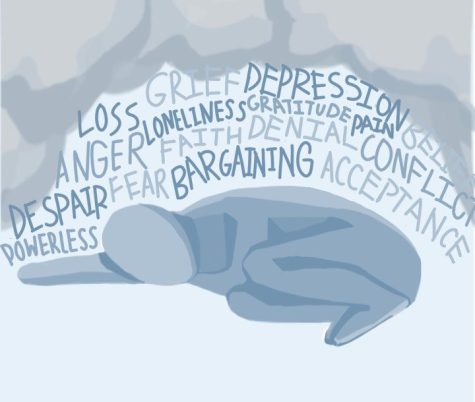Vaping: an alternate take on cigarettes
Growing up, senior Miles Wong* often felt alone. His best friend passed away in front of him when he was nine years old. That same day, his mom was diagnosed with cancer, and his parents spent much of their time in the hospital. Wong had to raise himself. During his sophomore year, he started smoking. The smell, the texture, the way the cigarette fit in his hand gave him a sense of comfort and relief. Soon, he was smoking one pack a day. He noticed his lungs were getting weaker, and his doctor recommended that he switch to using e-cigarettes. Wong now uses a vaping device to help him cope with nicotine cravings.
“At first, I was doing cigarettes for fun and relaxation,” said Wong. “Then, I was addicted and I just couldn’t breathe, so I had to quit. Vaping is a lot cleaner than smoking cigarettes, and it’s less stress on my lungs.”
Decades ago, cigarette use among teens was on the rise. Recently, however, a new phenomenon has surfaced: vaping. Vapes, or e-cigarettes, frequently come in the form of sleek pens that resemble flash drives, with a temperature regulation device and a charger on one end, and an interchangeable mouthpiece with vaping liquids, or “pods,” on the other. Pods can come in multiple flavors ranging from mint to cotton candy and deliver the heated vaping liquid through vapor that is then inhaled. Some liquid formulas contain only water, propylene glycol and flavoring, while others are nicotine-based, containing as much nicotine as one pack of cigarettes.
“When you vape with nicotine, you feel a sensation called a Head Rush that lasts for a maximum of two minutes,” said junior Gerald Douglas*. “Your muscles feel tense, and it feels like you are sinking to the ground.”
One of the most popular types of vape products is made by Juul, a San Francisco-based company that created its products with the intention of helping adults who have trouble quitting smoking. Juul and a few other e-cigarette companies ensure that online purchasers are 21 or older. Nonetheless, even though federal law prohibits the sale of e-cigarettes to anyone under 18, teenagers have been able to gain access to vaping devices. For those who have nicotine addictions from smoking cigarettes, vaping has become a cleaner and healthier alternative that does not immediately tarnish their lungs with tar.
“I started smoking cigarettes my freshman year because my friends were doing it, and then it became an addiction,” said former Lynbrook student and senior Aymie Dang, who currently uses a Phix, a pod vaping system similar to Juul, after quitting cigarettes. “The smell of cigarettes would stay on me when I went to class and it was kind of embarrassing. But the vape doesn’t do that.”
Recently, however, more teens have started vaping not because they have nicotine addictions, but to fit in with social norms and display their use on social media. For instance, videos in which teens perform vaping tricks, such as blowing rings of smoke into the air, have led many youths to perceive vaping as not only socially acceptable, but cool.
“If it weren’t for social media, I don’t think half the people that vape today would be vaping,” said Dang. “It bothers me so much when I see a teen using a vape with nicotine when they don’t have [a previous cigarette addiction], because you’re so young. You’re poisoning your body just to seem cool.”
Others who enjoy vaping appreciate its social aspects. Whether it is at a local vape shop or at an event, vaping has created a thriving social scene, allowing many people to have fun and make friends.
“I like using it with my friends,” said Douglas. “You know how people drink beer together? It’s kind of like that. It’s like a new culture among students. It’s not healthy, but it’s like the new trendy thing.”
Since e-cigarettes are a relatively new innovation, the long-term health effects of vaping are currently unknown. Although they provide a safer alternative to traditional cigarettes, e-cigarettes do not come without risks. Some health professionals claim that even though vape products were originally created to help people with cigarette addictions reduce their nicotine intake, they have also contributed to the rise of nicotine use among youths due to their prevalence. Recent years have shown more evidence that e-cigarette use in youth increases the risk of further tobacco product use.
“Nicotine is a highly addictive substance, and teenagers are particularly vulnerable to nicotine addiction,” said Nick Goldenson, a doctoral student at the University of Southern California’s Health, Behavior and Addiction Laboratory. “Exposure to nicotine during adolescence can harm the developing brain, leading to deficits in attention, cognition and impulse control as well as other mental health problems.”
Just like any substance, vaping has a considerable financial downside for those who do it regularly — a single vape pod can cost up to $20.
“What I worry about is not people’s health but more of their financial problems,” said Douglas. “On average, my friends and I go through a pod in four or five days, and with each pod costing around $20, it adds up.”
Some, however, believe the damage caused by the alternative, cigarettes, outweighs the cost of vape pods.
“My parents support me vaping,” said Wong. “They want me to get off [cigarettes], so they say they’ll cover my pod costs for now.”
At Lynbrook, teachers have seen a rise in the number of students who vape over the years, and they hope students will take calculated risks and think of the possible long-term consequences.
“When I was younger, there was the impression that dipping tobacco was safer because there was no smoke, but we later realized that wasn’t true,” said special education teacher Miguel Alderete. “I know people who have throat cancer because of dipping tobacco. My hope for students is to hear me now, but listen to me later.”
Teachers hope that students will take care of their bodies, but also realize that their previous mistakes do not define them.
“Every action you make is a small pebble that ripples in your body of water; some for the worst,” said science teacher Jason Lee. “But the great thing is your body is incredible at recovering. The hardest part of your body to recover and find balance in is your brain, especially when it comes to establishing connections of happiness. To me, this is the basis of why people vape: it makes you feel happy, it makes you forget about stressful things and it allows you to chill. This is where you can become neurologically dependent on it, and dollars to donuts frequency and consistency is a primary factor.”
In past decades, teens have not only used substances to rebel and experiment, but also to cope with underlying issues such as mental health, stress caused by academics and various aspects of their personal lives.
“Mental health is looked down upon in society. If you struggle with mental health, you’re considered weak,” said Wong. “But mental health isn’t a joke. Some people do things because they want to. Some people do things because they have to.”
At Lynbrook, substance use can be taboo, with students judging those who smoke, vape or use other drugs without knowing the background behind or cause of such behavior.
“Judgement feels like sh*t,” said Wong. “You feel like everyone’s against you. You feel alone. You feel anxious and depressed. Don’t judge people too fast because you never know what they’re going through.”
According to a 2008 study of 35 years of tobacco cessation studies, surveys showed that although 70 percent of smokers wanted to quit, less than 5 percent were successful due to nicotine addiction. Yet through vaping, both teens and adults have found ways to stay away from the toxicants in combustible tobacco cigarettes and gradually reduce their nicotine intake. Still, this notion comes from anecdotal evidence, such as testimonials. There is limited documentation of patterns demonstrating that vaping may promote smoking cessation, and more research is needed in this area. Furthermore, a research paper recently published by “Environmental Health Perspectives” concluded that e-cigarettes can potentially introduce toxic metals from the heating coil to the inhaled aerosol, demonstrating that nicotine-free vapor may not be completely safe either.
Because vaping has possible negative health effects, teens looking to experiment should do so cautiously. Moreover, it is important for Lynbrook students and teachers to consider the factors that may lead someone to use substances, whether they be stress or mental health issues, and show compassion instead of judgement.
“When people read this story, I want them to realize that they’re not alone,” said Wong. “I didn’t give a f*ck about my life. But now I treasure my life. My best friend who passed away inspired me so much. He always had a positive energy to him, and I want to bring positive energy and show people that if you set your mind to something, you can accomplish it. If you want to quit cigarettes, put your mind to it.”
*names have been kept anonymous for privacy reasons

Risa Mori is a senior and the In-Depth Section Editor for the Epic. In her free time, she loves to watch movies and dramas, listen to her favorite music,...

Patricia is a senior and a web director for the Epic. To her, journalism is a way of seeing the world with curiosity and compassion. She believes that...







































































